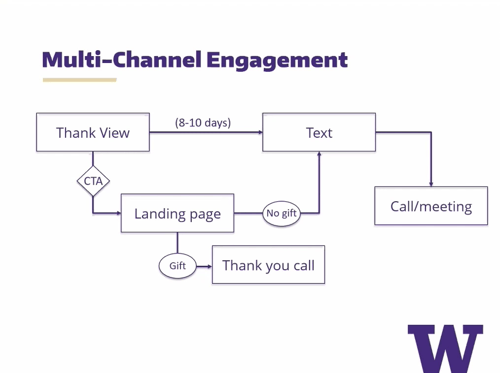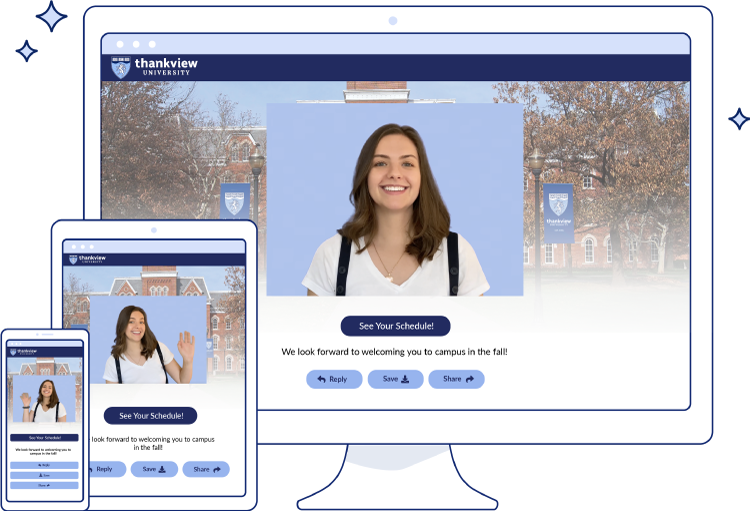Key Takeaways from the CASE All Districts Conference
Our team had a fantastic time at the All Districts conference! There were many great speakers and sessions, but here are the highlights from just a few of those we attended.
Breaking News Matters. And It Works.
Doug Most, Assistant Vice President, Executive Editor, Boston University
There are five initial questions you need to ask to decide if a story is worth pursuing:
- Will your audience care? Knowing your audience is critical.
- Do you have the experts to make your story, and therefore your institution, stand out?
- Will the story have legs? Will it be a hiccup seen on social media for only four hours or will it last longer?
- How quickly do we have to react and post a story in order to take advantage of the breaking news? A few hours? The next day? Within a week?
- Are other media pursuing the story and does that matter?
Once you’ve answered these if the story is something you should cover, remember: transparency is key. Approach the subject openly and use experts to make sure you have all of the facts and have considered the different angles and viewpoints you could take.
Here are an additional five tips to be faster, build audience, and stay relevant:
- Publish, update, post, and share – if you can publish at noon, publish, don’t wait. Update the story as it develops, rather than waiting for the finished version. Use social to push it hard. And republish the next day to ensure maximum visibility.
- Use national news to be part of the conversation, extend your brand, and be relevant to your audience.
- Q&As with faculty experts are fast formats that require less writing and can be turned around in an hour or two.
- Make researchers feel special by using their research to connect with the news and share more in-depth perspectives.
- Start early! If you can assign a story at 9am, do it. Again, getting it published by noon will always help expand your audience.
Students as Content Creators and Brand Ambassadors
Jessica Mandra, Multimedia Designer, Harper College
One of the best ways to amplify your fundraising is to use student ambassadors as peer-to-peer influencers. At Harper College, creating this program meant evaluating not just which students to coach, but also what support systems the central office would need to help them reach out to their networks.
First, they created a student Instagram to leverage one of the strongest social networks for young alumni. Students submitted photos documenting the student life experience and their engagement on campus and then worked with staff to create the language for them to post. The College also allowed students to create the student tour that they’d want to see, showcasing new aspects of the institution not previously included.
The major takeaway for building brand ambassadors? Allow them to create the content. If you manage every aspect of content creation you will dampen the creativity and authenticity that ambassadors naturally provide to uplift your brand.
Building a Digital Gift Officer Program
Josh Glantz, Digital Gift Officer, University of Washington, Kifaya Dawud, Digital Gift Officer, University of Washington, and Jennifer MacCormack, Director, Advancement Analytics, University of Washington
Before approaching your strategy for a program like this, remember that the number one goal of a digital gift officer is donor retention.
The University of Washington took this approach and began by creating an ecosystem of digital tools to empower their gift officers. this included:
- ThankView for videos for donor introduction, cultivation, and stewardship. Because donors can see and hear the fundraiser, this creates a personal connection.
- Personalized landing pages showing unique gift opportunities relevant to the prospect’s interests.
- Text campaigns to reach donors on their mobile devices and foster two-way conversation.

Digital Gift Officers use Thankview as an introduction and to request a conversation. They record a video that is less than 30 seconds and includes CTA links to the personalized giving pages. It is not uncommon to see upwards of 50% open rates in the first 24 hours of sending a video!
Days of Giving Success and Lessons Learned for Small Colleges
Christian Barnes, Director of Annual Giving, Murray State University, Sarah Byrd, Executive Director of Alumni Engagement and Annual Giving, Knox College, Patrick Hunt, Director, Data Services, University of California, Merced, Miranda Peruso, Director of Annual Giving, Juniata College, and Mirko Widenhorn, Senior Director of Engagement Strategy, Anthology
This was a panel discussion between Juniata College, Knox College, Murray State University, and UC Merced.
Juniata College
- Faced with hosting their Giving Challenge amidst the COVID-19 pandemic
- Encouraged giving to the Annual Fund with a focus on unrestricted dollars and giving to the emergency fund
- Created a dollar for dollar matching challenge to incentivize donors to double their impact and help them reach their goals
Knox College
- Also faced the challenge of moving forward with their Day of Giving during the pandemic
- They incorporated thematic elements to strengthen their event’s brand about why the world needs liberal arts grads – especially during these challenging times.
- They tailored their giving challenges and broke out unique donor segments to send specific opportunities in order to reduce their overall communication footprint to individual donors. In order to achieve this, they aligned themselves closely with Advancement services to create a seamless process to help identify segments and create the corresponding lists.
Murray State
- Launched Racers Give, a ‘Week of Giving’ campaign to raise funds for need-based scholarships.
- Their promotion primarily operated through targeted emails to faculty and staff, engaging social media strategies, and through the steady promotion of fundraising challenges and matching gifts.
UC Merced
- Split fundraising priorities into one giving day + 30 days of year-end giving initiatives.
- Throughout these campaigns, they sent 31 email messages (with 400,000 emails delivered).
- They also leveraged 29 unique matching and challenge gift opportunities to incentivize participation.
Elevating Expertise: Leveraging Faculty and Staff Experts Across Communications Platforms
Sunni Brown, Director of Media and Public Relations, University of Richmond, and Lindsey Campbell, Media Relations Specialist, University of Richmond
The University of Richmond is constantly thinking of how to elevate their brand pillars by showcasing their faculty, what they are researching, teaching, etc., and focusing on how to highlight that through their communications and in the media. This helps to provide awareness around the fact that University of Richmond is a powerhouse with expert faculty.
The University is also always tracking the news and finding reporters who would have an interest in working with their experts. This helps create long-lasting relationships between them and those who can amplify their PR footprint.
They pursue a mix of traditional and digital mediums when elevating expertise including an online newsroom and the use of social media specifically for media relations to target reporters and to highlight placement. They place an emphasis on diversifying their digital channels to include all types of school communications and to share across a wide breadth and depth of channels.
If you are looking to start your own elevation program the steps are simple: audit your information intake process, nurture your relationships, pitch your colleagues, and share, share, share!
Panel Conversation: The Future of Global Advancement
Moderated by CASE President and CEO, Sue Cunningham and featuring Eduardo Behrentz, Teresa Flannery, Jim Moore, and Deep Saini
Over the course of the past year, so much has happened that was unprecedented. Using different CASE competencies has been a crucial tactic among these four leaders throughout the entire year.
Learning lessons include making sure to maintain empathy within your engagement, having strong leadership, and not being afraid to change the status quo. Quick and confident actions allowed these leaders to execute plans throughout the year, along with maintaining strong relationships and emphasizing communication.
Key takeaway: remember that looking forward, the vision of your organization’s future is long-term and is a balance of evidence-informed decision making, leadership, and a high degree of emotional intelligence.
“You can’t crunch people into numbers” – Deep Saini
Transformative Gifts from Non-Alumni: What Makes Them Tick and Why They’re Worth the Effort
Kristen DeVries, Vice President and Executive Director, Western Michigan University Foundation, Brian O’Leary, Managing Consultant, Graham-Pelton, and Elizabeth Zeigler, President and CEO, Graham-Pelton
Major donors look to have a real impact on their community. With smaller institutions, major donors have the opportunity for their gift to have a larger impact than it may have at a larger institution.
Non-alumni giving is strong among higher education, but you must understand the non-alumni donor first. They are usually located within the region, have multi-pronged relationships through their business, may have family ties, and are looking to improve the region and community of the institution.
Key takeaway: people do want to be appreciated; everyone has a role to play in the success of fundraising!
Giving Circles: Expanding Our Reach by Focusing Our Touch
Heidi Bortel, Director of Development Women’s Initiatives, Miami University, Mark Gaines, Senior Director of Development – Diversity and Inclusion, Purdue University, Joyce Rodgers, Vice President for Development and External Relations for OVPDEMA, Indiana University, and Chelsea Smock, Associate Director, Alumni Relations & Engagement, Butler University
Giving Circles are all about diversity in support; garnering support from different aspects of your community. If you put the resources in, you will see the impact.
Engagement is crucial around giving circles: you must allow your volunteers to step up and have ownership of decisions. This will help your institution to continue to authentically cultivate giving circles to higher levels of giving.
Key takeaway: Giving is an emotional engagement, and Giving Circles provide an opportunity to facilitate that.
Data, Diversity, and Alumni Identities: A Modern Case for Support of Higher Education Philanthropy
Jay Dillon, Executive Director, Alumni Relations, University of California, Berkeley
There is a huge disparity between alumni of color and white alumni in terms of volume, engagement, event attendance, and more. In fact, alumni of color are underrepresented in engagement as well as giving.
The alumni community is diverse, but there is a problem within the data. It isn’t up to the alumni to feel welcome—that is on the institution. You must create space for all alumni to feel welcome. Alumni identity can be a metric to gauge success. It is how connected an alumnus feels about their institution. Alumni of color and white alumni both share the same level of alumni identity of their alma mater.
Key takeaway: the focus should shift to building inclusive programs for all alumni by including alumni identity as a consideration at the inception of every campaign and program.
Inside the Journey and Results of Implementing and Adopting Artificial Intelligence
Mark Hobbs, CEO, Fundmetric, Mark Koenig, Chief Innovation Officer and Vice President of Technology, Oregon State University Foundation, and Greg Lee, Lead Data Scientist, Fundmetric
OSU is leading the way in digital transformation in higher education. To make this happen they set up an innovation fund to seed ideas and projects internally.
AI is a top-down implementation and it is required to get buy-in throughout the organization. The digital transformation at OSU started with their new CRM and the related applications enhancing the donor experience. To achieve this goal, they had to break down their ‘cylinders of success’ to get their departments out of their silos.
For a project of this magnitude, it’s crucial to let go of the old ways across the board, vertically and horizontally. The most important thing for an org considering this? Trust.
